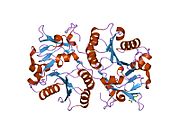Biology:B3GAT1
 Generic protein structure example |
3-beta-glucuronosyltransferase 1 (B3GAT1) is an enzyme that in humans is encoded by the B3GAT1 gene, whose enzymatic activity creates the CD57 epitope on other cell surface proteins.[1] In immunology, the CD57 antigen (CD stands for cluster of differentiation) is also known as HNK1 (human natural killer-1) or LEU7. It is expressed as a carbohydrate epitope that contains a sulfoglucuronyl residue in several adhesion molecules of the nervous system.[2]
Function
The protein encoded by this gene is a member of the glucuronyltransferase gene family. These enzymes exhibit strict acceptor specificity, recognizing nonreducing terminal sugars and their anomeric linkages. This gene product functions as the key enzyme in a glucuronyl transfer reaction during the biosynthesis of the carbohydrate epitope HNK-1 (human natural killer-1, also known as CD57 and LEU7). Alternate transcriptional splice variants have been characterized.[1]
Immunohistochemistry
In anatomical pathology, CD57 (immunostaining) is similar to CD56 for use in differentiating neuroendocrine tumors from others.[3] Using immunohistochemistry, CD57 molecule can be demonstrated in around 10 to 20% of lymphocytes, as well as in some epithelial, neural, and chromaffin cells. Among lymphocytes, CD57 positive cells are typically either T cells or NK cells, and are most commonly found within the germinal centres of lymph nodes, tonsils, and the spleen.[4]
There is an increase in the number of circulating CD57 positive cells in the blood of patients who have recently undergone organ or tissue transplants, especially of the bone marrow, and in patients with HIV. Increased CD57+ counts have also been reported in rheumatoid arthritis and Felty's syndrome, among other conditions.[4] High levels of CD57 expression amongst circulating CD8+ T cells is associated with other markers of immune ageing (immunosenescence) and may be associated with increased cancer risk in renal transplant recipients.[5]
Neoplastic CD57 positive cells are seen in conditions as varied as large granular lymphocytic leukaemia, small-cell carcinoma, thyroid carcinoma, and neural and carcinoid tumours. Although the antigen is particularly common in carcinoid tumours, it is found in such a wide range of other conditions that it is of less use in distinguishing these tumours from others than more specific markers such as chromogranin and NSE.[4]
References
- ↑ 1.0 1.1 "Entrez Gene: B3GAT1 beta-1,3-glucuronyltransferase 1 (glucuronosyltransferase P)". https://www.ncbi.nlm.nih.gov/sites/entrez?Db=gene&Cmd=ShowDetailView&TermToSearch=27087.
- ↑ "Cloning and chromosomal mapping of human glucuronyltransferase involved in biosynthesis of the HNK-1 carbohydrate epitope". Genomics 65 (2): 166–173. April 2000. doi:10.1006/geno.2000.6152. PMID 10783264.
- ↑ Wick, Mark R. (2010). "Chapter 11 – Immunohistology of the Mediastinum". Diagnostic immunohistochemistry: theranostic and genomic applications (3rd ed.). Philadelphia, PA: Saunders/Elsevier. pp. 345–6. doi:10.1016/B978-1-4160-5766-6.00015-7. ISBN 978-1-4160-5766-6.
- ↑ 4.0 4.1 4.2 Leong, Anthony S.-Y.; Cooper, Kumarasen; Leong, F. Joel W.-M. (2003). Manual of Diagnostic Antibodies for Immunohistology (2nd ed.). London: Greenwich Medical Media. pp. 131–134. ISBN 978-1-84110-100-2.
- ↑ "CD8+ Immunosenescence Predicts Post-Transplant Cutaneous Squamous Cell Carcinoma in High-Risk Patients". Journal of the American Society of Nephrology 27 (5): 1505–1515. May 2016. doi:10.1681/ASN.2015030250. PMID 26563386.
Further reading
- "A "double adaptor" method for improved shotgun library construction". Analytical Biochemistry 236 (1): 107–113. April 1996. doi:10.1006/abio.1996.0138. PMID 8619474.
- "Large-scale concatenation cDNA sequencing". Genome Research 7 (4): 353–358. April 1997. doi:10.1101/gr.7.4.353. PMID 9110174.
- "Characterization of recombinant human glucuronyltransferase I involved in the biosynthesis of the glycosaminoglycan-protein linkage region of proteoglycans". FEBS Letters 459 (3): 415–420. October 1999. doi:10.1016/S0014-5793(99)01287-9. PMID 10526176.
- "Cloning and chromosomal mapping of human glucuronyltransferase involved in biosynthesis of the HNK-1 carbohydrate epitope". Genomics 65 (2): 166–173. April 2000. doi:10.1006/geno.2000.6152. PMID 10783264.
- "Heparan/chondroitin sulfate biosynthesis. Structure and mechanism of human glucuronyltransferase I". The Journal of Biological Chemistry 275 (44): 34580–34585. November 2000. doi:10.1074/jbc.M007399200. PMID 10946001.
- "Function and molecular modeling of the interaction between human interleukin 6 and its HNK-1 oligosaccharide ligands". The Journal of Biological Chemistry 277 (14): 12246–12252. April 2002. doi:10.1074/jbc.M106816200. PMID 11788581.
- "The donor substrate specificity of the human beta 1,3-glucuronosyltransferase I toward UDP-glucuronic acid is determined by two crucial histidine and arginine residues". The Journal of Biological Chemistry 277 (28): 25439–25445. July 2002. doi:10.1074/jbc.M201912200. PMID 11986319.
- "Expression of CD57 defines replicative senescence and antigen-induced apoptotic death of CD8+ T cells". Blood 101 (7): 2711–2720. April 2003. doi:10.1182/blood-2002-07-2103. PMID 12433688.
- "Different patterns of chromogranin A and Leu-7 (CD57) expression in gastrointestinal carcinoids: immunohistochemical and confocal laser scanning microscopy study". Neoplasma 50 (1): 1–7. 2003. PMID 12687271.
- "beta-1,3-Glucuronyltransferase-1 gene implicated as a candidate for a schizophrenia-like psychosis through molecular analysis of a balanced translocation". Molecular Psychiatry 8 (7): 654–663. July 2003. doi:10.1038/sj.mp.4001382. PMID 12874601.
- "The increase of CD57+ T cells in the peripheral blood and their impaired immune functions in patients with advanced gastric cancer". Oncology Reports 10 (5): 1443–1448. 2004. doi:10.3892/or.10.5.1443. PMID 12883721.
- "Structural basis for acceptor substrate recognition of a human glucuronyltransferase, GlcAT-P, an enzyme critical in the biosynthesis of the carbohydrate epitope HNK-1". The Journal of Biological Chemistry 279 (21): 22693–22703. May 2004. doi:10.1074/jbc.M400622200. PMID 14993226.
- "Acute lymphoblastic leukemia with coexpression of CD56 and CD57: case report". Pediatric Hematology and Oncology 21 (7): 677–682. 2005. doi:10.1080/08880010490501105. PMID 15626024.
- "Expression of killer cell lectin-like receptor G1 on antigen-specific human CD8+ T lymphocytes during active, latent, and resolved infection and its relation with CD57". Journal of Immunology 174 (10): 6088–6094. May 2005. doi:10.4049/jimmunol.174.10.6088. PMID 15879103.
- "Collagen type IX and HNK-1 epitope in tears of patients with pseudoexfoliation syndrome". Biochimica et Biophysica Acta (BBA) - Molecular Basis of Disease 1762 (1): 54–58. January 2006. doi:10.1016/j.bbadis.2005.09.005. PMID 16257185.
- "Evidence of calcium-dependent pathway in the regulation of human beta1,3-glucuronosyltransferase-1 (GlcAT-I) gene expression: a key enzyme in proteoglycan synthesis". FASEB Journal 20 (10): 1692–1694. August 2006. doi:10.1096/fj.05-5073fje. PMID 16807373.
- "Characterization of a cytotoxic CD57+ T cell subset from patients with pulmonary tuberculosis". Clinical Immunology 121 (3): 314–323. December 2006. doi:10.1016/j.clim.2006.08.011. PMID 17035093.
External links
- CD57+Antigen at the US National Library of Medicine Medical Subject Headings (MeSH)
- Human B3GAT1 genome location and B3GAT1 gene details page in the UCSC Genome Browser.
 |




